Are you wondering if you should use a record weight to enhance your vinyl listening experience? Well, you’ve come to the right place!
As a vinyl enthusiast and audio gear junkie, I’ve spent countless hours experimenting with different setups to achieve the perfect sound. Let me share my insights on record weights and help you decide if they’re worth adding to your turntable setup.
Should you use a record weight? Yes, in most cases, using a record weight can significantly improve your vinyl listening experience.
Record weights help stabilize the vinyl on the platter, reducing vibrations and resonance, which leads to better sound quality, improved tracking, and more stable playback. They’re especially beneficial for slightly warped records or turntables with lighter platters.
However, it’s essential to ensure your turntable can handle the additional weight without causing damage to the motor or bearings.
Now, I know you’re probably itching to learn more about these nifty little accessories. Don’t worry, we’re gonna dive deep into the world of record weights and explore all the juicy details that’ll help you make an informed decision for your setup.
Trust me, by the end of this article, you’ll be a record weight pro!
Why Use A Weight Over A Turntable?
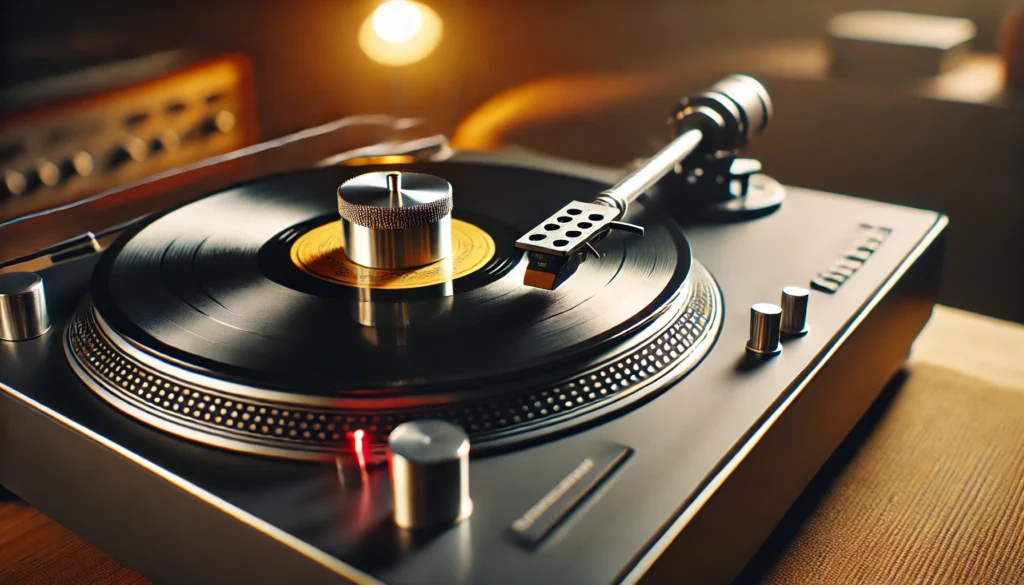
Alright, let’s talk about why you might want to use a weight over your turntable. Picture this: you’re all set for a cozy evening with your favorite vinyl, but as soon as the needle hits the groove, you hear that annoying warp or flutter.
Ugh, talk about a mood killer! That’s where a record weight comes in handy.
Using a weight over your turntable can work wonders for your listening experience. First off, it helps press the record flat against the platter, which is super helpful for those slightly warped records we all have (don’t pretend you don’t!).
This improved contact means better tracking and less distortion – music to any vinyl lover’s ears!
But that’s not all, folks! A weight also adds mass to the platter system, which helps dampen vibrations.
Think of it like adding shock absorbers to your car – suddenly, those bumps in the road (or in this case, imperfections in your vinyl) become way less noticeable. The result? Clearer sound, tighter bass, and an overall more stable playback.
Now, I know what you’re thinking – “But won’t that extra weight hurt my turntable?” It’s a valid concern, and we’ll dive into that later. For now, just know that for most modern turntables, the benefits of using a weight usually outweigh (pun intended!) any potential drawbacks.
But hey, don’t take my word for it – let’s explore this topic more deeply below and you can decide for yourself!
What is a Record Weight?
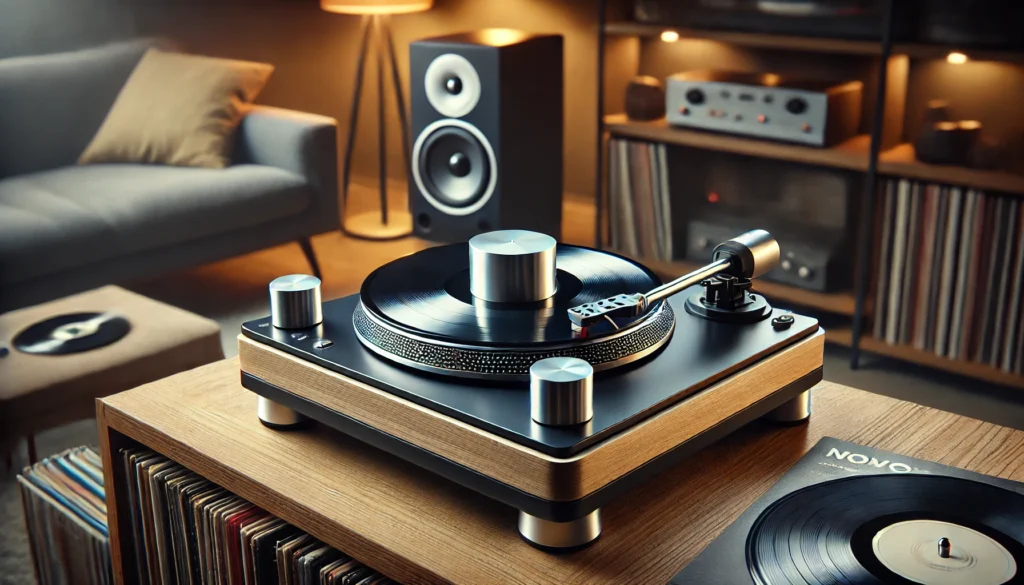
Oh boy, where do I start? Record weights are like the unsung heroes of the vinyl world.
I remember the first time I saw one, I thought, “What’s this fancy paperweight doing on a turntable?” Little did I know, these bad boys are so much more than just pretty accessories.
A record weight, also known as a record clamp or stabilizer, is basically a heavy disk that sits on top of your vinyl record while it’s playing. They come in all shapes and sizes, from sleek metal discs to elaborate contraptions that look like they belong in a sci-fi movie.
But don’t let their looks fool you – their purpose is dead serious.
The main job of a record weight is to stabilize your vinyl as it spins. It’s like giving your record a big, heavy hug while it’s doing its thing.
This extra weight helps press the record firmly against the platter, which can work wonders for your sound quality.
Now, there are a few different types of record weights out there. You’ve got your basic weights that just sit on top of the spindle, and then you’ve got clamps that actually screw down onto the spindle.
Some audiophiles swear by one type over the other, but in my experience, both can do the job well if used correctly.
So, how do these things actually work? Well, it’s all about physics, baby!
By adding mass to the record-platter system, a weight helps dampen vibrations and resonances. It’s like adding insulation to your walls – suddenly, all that outside noise (or in this case, unwanted vibrations) gets muffled.
But here’s where it gets really cool: a good record weight can actually help flatten out slightly warped records. I can’t tell you how many times I’ve rescued an old, beloved album from the “unplayable” pile with the help of a weight.
It’s like magic!
Should I use a record weight?
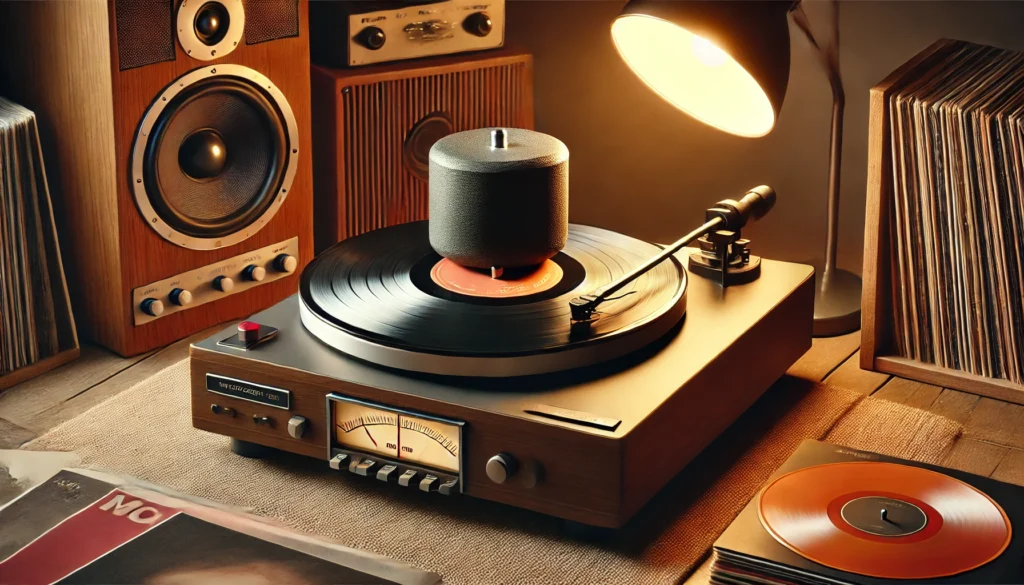
Yes, in most cases, you should use a record weight. Record weights can significantly improve your vinyl listening experience by stabilizing the record, reducing vibrations, and enhancing sound quality.
They’re particularly beneficial for slightly warped records or turntables with lighter platters. However, it’s crucial to ensure your turntable can handle the additional weight without causing damage to the motor or bearings.
While record weights offer many benefits, they’re not a one-size-fits-all solution. In the rest of this article, we’ll dive deeper into the world of record weights, exploring their pros and cons, and helping you make an informed decision for your unique setup.
Benefits of Using a Record Weight
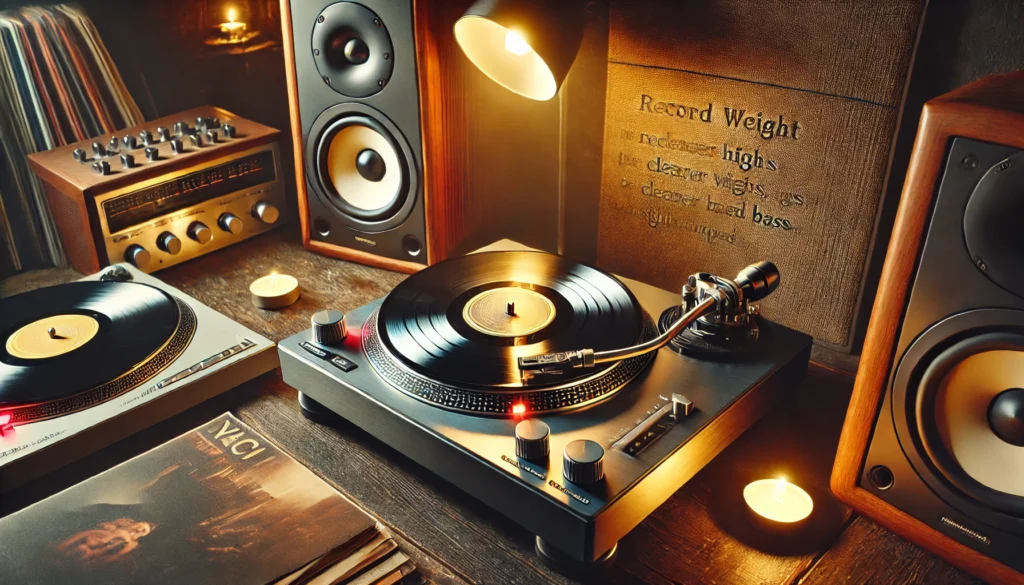
Let me tell you, the first time I slapped a record weight on my turntable, it was like hearing my vinyl collection for the first time all over again. The benefits are real, folks, and they can be pretty darn impressive.
First up, let’s talk about sound quality. This is the biggie, the reason most of us get into this hobby in the first place.
A good record weight can seriously up your audio game. By pressing the record firmly against the platter, it improves the coupling between the two.
What does that mean in English? Basically, it helps your stylus track the groove more accurately.
The result? Clearer highs, tighter bass, and an overall more detailed sound.
It’s like cleaning your glasses – suddenly, everything comes into focus!
But wait, there’s more! (Sorry, couldn’t resist the infomercial vibe there.) One of the biggest benefits I’ve noticed is the reduction in vibration and resonance.
You know that annoying thing where your speakers cause your turntable to vibrate, which then causes more distortion, which then… well, you get the picture. A record weight helps break this feedback loop by damping those pesky vibrations.
It’s like telling your audio setup, “Hey, chill out, man!”
And let’s not forget about playback stability. This was a game-changer for me, especially with some of my older, slightly warped records.
A good weight can help iron out those minor imperfections, leading to more consistent playback. No more speed wobbles or pitch variations – just pure, sweet music.
I remember playing an old jazz record that always had this annoying flutter in one section. Slapped on a weight, and boom! Smooth as butter.
It was like rediscovering the album all over again.
Potential Drawbacks of Record Weights
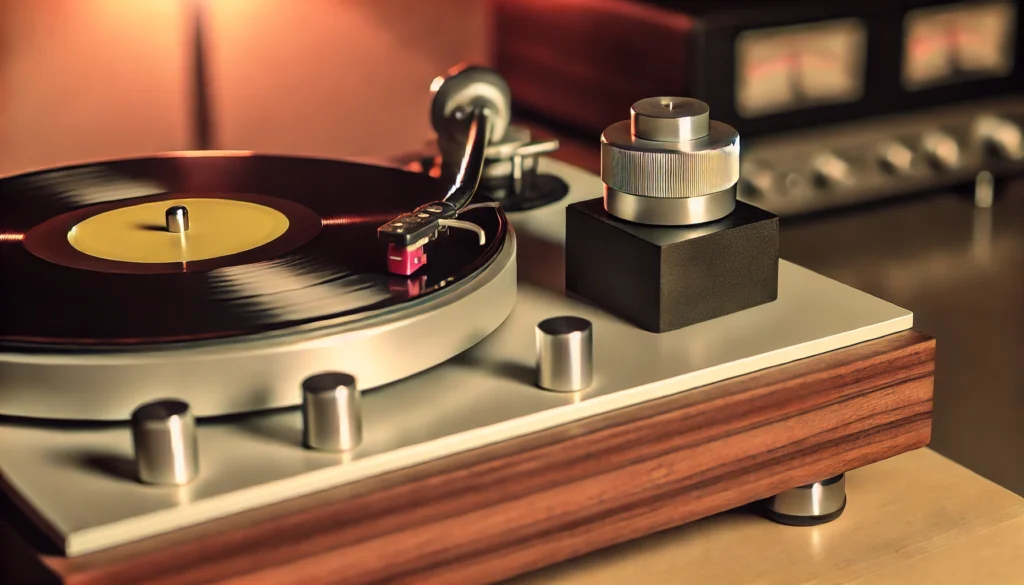
Now, I know I’ve been singing the praises of record weights, but let’s keep it real for a minute. They’re not all sunshine and rainbows, and there are a few potential downsides you should be aware of.
Trust me, I learned some of these the hard way!
First up, let’s talk about wear and tear on your turntable. Adding extra weight to your platter means your turntable’s motor and bearings have to work harder.
It’s like asking your car to carry a heavy load – sure, it can do it, but it might not be great for long-term health. I once got a bit too enthusiastic with a particularly heavy weight and ended up with a burned-out motor.
Not my finest moment, let me tell you!
Then there’s the compatibility issue. Not all turntables are created equal, and some just don’t play nice with record weights.
I learned this lesson when I tried to use my fancy new weight on a friend’s vintage turntable. Let’s just say it didn’t end well, and I had some explaining (and apologizing) to do.
But here’s the kicker – and this one really got me – record weights can actually damage warped records if you’re not careful. I know, I know, earlier I said they can help with warps.
And they can! But if you’ve got a severely warped record and you slap a heavy weight on it, you’re basically forcing it flat against the platter.
This can stress the vinyl and potentially cause even more damage. I learned this the hard way with a prized first pressing that I was trying to “fix”.
Spoiler alert: it didn’t end well.
So yeah, while record weights can be awesome, they’re not a magic bullet. You’ve gotta use them wisely and be aware of their limitations.
But hey, that’s half the fun of this hobby, right? Learning from our mistakes and all that jazz.
How to Choose the Right Record Weight
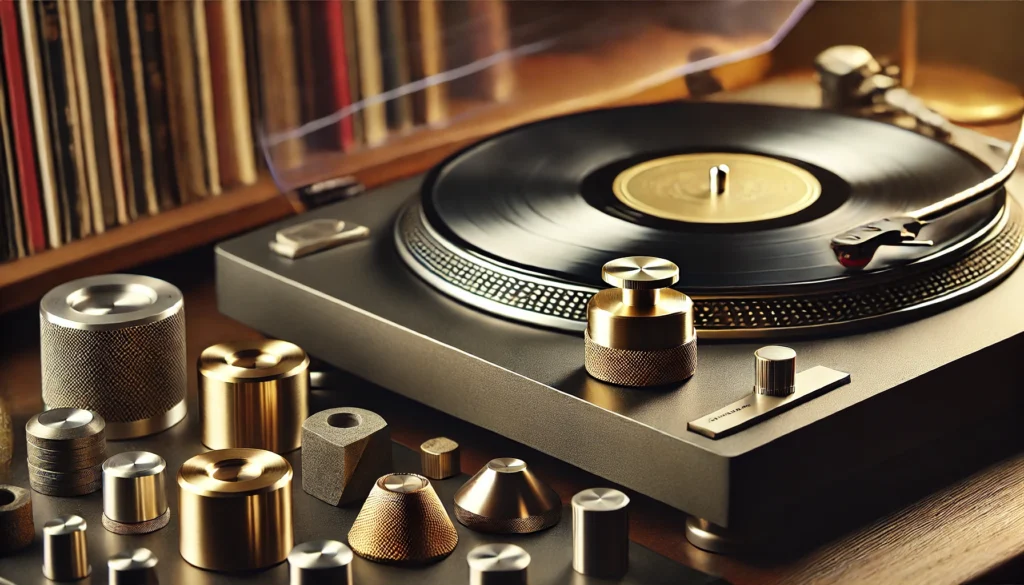
Alright, so you’ve decided to take the plunge and get yourself a record weight. Awesome!
But now you’re staring at a sea of options, wondering which one to choose. Don’t worry, I’ve been there, and I’m here to help you navigate these tricky waters.
First things first, you gotta consider your turntable’s compatibility. This is crucial, folks.
You don’t want to end up like me, with a weight that’s too heavy for your poor turntable to handle. Check your turntable’s manual or manufacturer’s website for any weight limits or recommendations.
If in doubt, start with a lighter weight and work your way up.
Next up, let’s talk materials. You’ve got options ranging from aluminum to brass to fancy-pants carbon fiber.
Each material has its own properties that can affect sound. Personally, I’m a fan of brass weights.
They’re heavy enough to do the job without being too much for most turntables, and they’ve got a nice, warm sound to them. But hey, that’s just my preference – you might find you prefer the clarity of aluminum or the high-tech vibe of carbon fiber.
Size matters too, folks! You want a weight that covers a good portion of the label area without hanging over the edge of the record.
I once made the mistake of using a weight that was too small – it left a ring-shaped impression on my vinyl that I can still see to this day. Learn from my mistakes, people!
When it comes to installation and use, it’s pretty straightforward. Just place the weight gently on top of your record, centered around the spindle.
But here’s a pro tip: always lift the tonearm before removing the weight. I once got lazy and tried to slide the weight off while the record was still playing.
Let’s just say the resulting scratch taught me a valuable lesson!
Oh, and one more thing – don’t forget to re-adjust your vertical tracking angle (VTA) if you’re using a particularly heavy weight. It can change the angle of your tonearm, which can affect sound quality.
It’s a small detail, but hey, in this hobby, the small details are what make the difference between good sound and great sound.
Do I Need Two Turntable Weights?
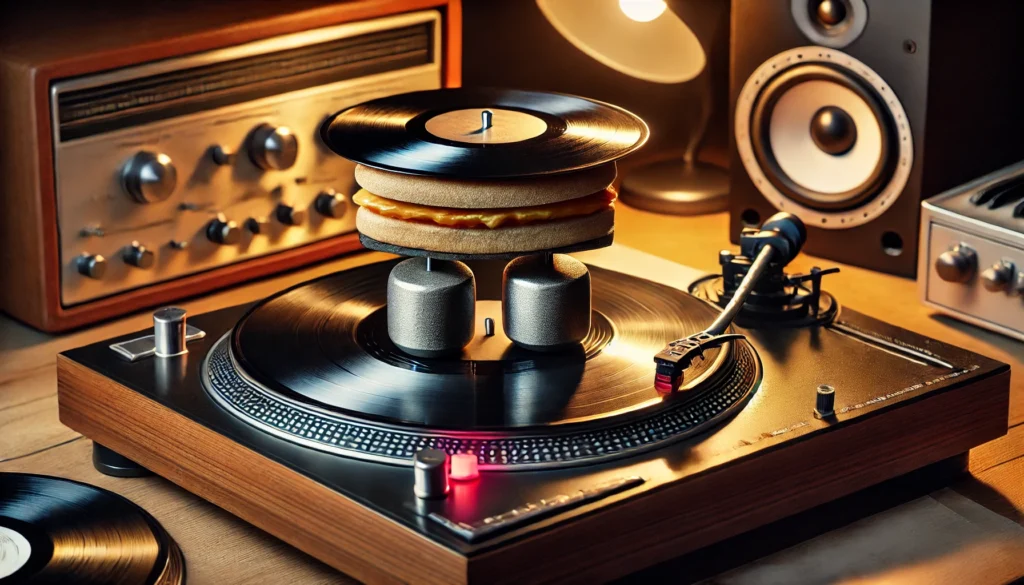
Ah, the age-old question: “If one is good, are two better?” When it comes to turntable weights, it’s not quite that simple. Let me break it down for you based on my own trials and tribulations in the world of vinyl.
First off, let’s talk about what using two weights actually means. Some folks swear by using a weight on top of the record (like we’ve been discussing) and another underneath the platter.
The idea is to create a kind of vinyl sandwich, with your record nestled snugly between two stabilizing forces.
Now, I’ll be honest – when I first heard about this, I thought it was overkill. But being the curious (and slightly obsessive) audiophile that I am, I had to try it out.
And you know what? In some cases, it actually made a noticeable difference!
The pros of using two weights are pretty straightforward. You get even more stability and vibration damping.
It’s like giving your record a bear hug from both sides. This can lead to even better tracking, especially with warped records.
I remember playing an old, slightly dish-shaped record with this setup, and it was like the warp had magically disappeared!
But (and it’s a big but), there are some serious cons to consider. For one, you’re adding a lot of extra weight to your turntable system.
This can put a real strain on your motor and bearings. I learned this the hard way when I tried this on an old belt-drive turntable – let’s just say the poor thing wasn’t up to the task.
Then there’s the hassle factor. Adding and removing two weights every time you want to play a record can get old real fast.
Trust me, the novelty wears off pretty quickly when you’re trying to DJ a party and you’re fumbling with weights between every song.
So, do you need two turntable weights? In most cases, probably not.
One good quality weight will usually do the trick. But if you’re dealing with a particularly problematic record, or if you’ve got a high-end turntable that can handle the extra mass, it might be worth experimenting with.
My advice? Start with one weight and see how it goes.
If you’re still not satisfied, then maybe consider adding a second. But always, always check your turntable’s specs first.
The last thing you want is to damage your precious vinyl-spinning machine in pursuit of that perfect sound.
Alternatives to Record Weights
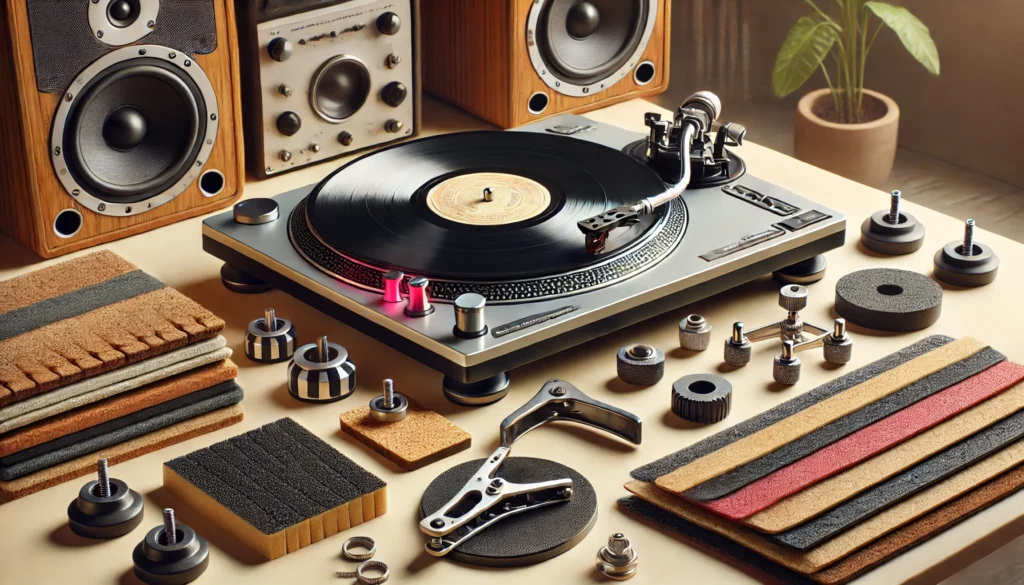
Okay, so maybe you’re not sold on the whole record weight thing. Or maybe your turntable just can’t handle the extra mass.
Don’t worry, my vinyl-loving friend, there are other ways to skin this cat (not that we’d ever want to skin a cat, mind you – it’s just an expression!).
Let’s start with record clamps. These bad boys work on a similar principle to weights, but instead of relying on mass, they use tension to hold the record in place.
They typically screw down onto your turntable’s spindle, pulling the record tight against the platter. I remember the first time I used a clamp – it was like night and day!
The improvement in sound quality was immediate and dramatic.
But clamps aren’t without their drawbacks. They can be a bit fiddly to use, especially if you’re changing records frequently.
And if you’re not careful, you can actually warp your records by over-tightening the clamp. Trust me, I learned that lesson the hard way with a prized first pressing.
Ouch!
Next up, let’s talk about turntable mats. These unassuming little discs can make a big difference in your sound.
They come in all sorts of materials – rubber, cork, leather, even fancy-pants carbon fiber. Each material has its own sonic signature.
Personally, I’m a fan of cork mats. They provide a nice balance of vibration damping and record coupling.
Plus, they look pretty cool!
I remember swapping out the stock felt mat on my first real turntable for a cork one. It was like lifting a veil from in front of my speakers.
Suddenly, everything sounded clearer and more detailed. And bonus – no more static cling!
Now, where was I? Oh yeah, other vinyl accessories!
Let me tell you about some of the other gadgets and gizmos I’ve tried in my quest for audio perfection.
One thing that made a surprising difference in my setup was a good set of isolation feet for my turntable. These little rubber or spring-loaded beauties help decouple your turntable from whatever surface it’s sitting on.
I remember the first time I installed a set – suddenly, footsteps in the room weren’t causing the needle to jump anymore. It was like magic!
Another option worth considering is a record vacuum cleaner. Now, I know what you’re thinking – “What does cleaning have to do with sound quality?” Trust me, I had the same thought at first.
But let me tell you, a really deep clean can make a world of difference. The first time I used a vacuum cleaner on an old, dusty record, it was like hearing it for the first time.
All that gunk in the grooves was masking so much detail!
Oh, and let’s not forget about cartridge alignment tools. These might not directly replace a record weight, but they can seriously improve your sound quality.
I spent an afternoon once really dialing in my cartridge alignment, and it was like someone had upgraded my whole system. The soundstage opened up, the imaging improved – it was night and day!
Now, I’ve got to mention one more thing – a good quality phono preamp. If you’re using the built-in preamp in your turntable or receiver, you might be surprised at what an upgrade can do.
I remember saving up for months to buy a decent external preamp. When I finally got it home and hooked it up, I was blown away.
It was like someone had lifted a blanket off my speakers!
At the end of the day, there’s no one-size-fits-all solution. What works magic for one setup might fall flat for another.
The key is to experiment, trust your ears, and most importantly, enjoy the music. After all, isn’t that what this hobby is all about?
Conclusion
Whew! We’ve been on quite a journey, haven’t we?
From diving deep into the world of record weights to exploring all sorts of alternatives, we’ve covered a lot of ground. So, let’s recap the main points and wrap this up with a nice bow, shall we?
Record weights can be a fantastic addition to your vinyl setup, potentially improving sound quality, reducing vibrations, and stabilizing playback. They’re especially helpful for slightly warped records or turntables with lighter platters.
However, they’re not without their drawbacks, including potential wear on your turntable and compatibility issues.
When choosing a record weight, remember to consider your turntable’s specifications, the weight’s material and size, and proper installation techniques. And hey, while two weights might seem like a good idea, for most setups, one high-quality weight will do the trick just fine.
But don’t forget, record weights aren’t the only game in town! Clamps, mats, isolation feet, cleaning tools, and even a good phono preamp can all contribute to better sound quality.
The key is to experiment and find what works best for your unique setup and listening preferences.
Remember, at the end of the day, this hobby is all about enjoying the music. Whether you decide to use a record weight, try out some alternatives, or stick with your current setup, the most important thing is that it brings you joy when you drop that needle.
So go ahead, give some of these options a try. Who knows?
You might just discover a whole new dimension to your favorite albums. And isn’t that discovery what makes this vinyl journey so exciting?
Now, I’d love to hear from you! What’s your experience with record weights or other vinyl accessories?
Any tips or tricks you’ve discovered along the way? Drop a comment below and let’s keep this conversation going.
After all, sharing knowledge is how we all grow in this wonderful world of vinyl. Happy listening, folks!
